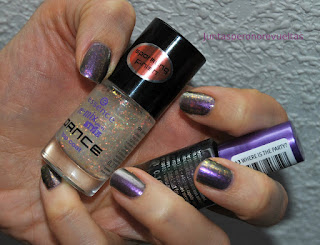Hola, chicas:
Hace no muchas entradas que os enseñé mi máquina overlock, y en esa entrada os comenté de pasada que había hecho una nueva manta de brochas (aunque para hacerla, no he utilizado la overlock). Bueno, en realidad he hecho 2: una para mí y otra para mi hermana.
La antigua que hice, y que os enseñé *
aquí*, está ya un poco deteriorada por el uso. Se había empezado a deshilachar, supongo que por el roce con las fundas para las brochas (que os enseñamos en *esta otra entrada*).
Hi girls,
When I showed you my overlock machine, just a few posts ago, I told you that I had made a new brushroll (although I didn't use the overlock to make it). Well, I actually made 2: one for me and the other one for my sister.
The old one I made, which I showed you *
here*
, is a bit damaged and worn from use. It had started to fray because the brush guards (which we showed you on *this post*) touched the fabric all the time.
Desde que pensé en hacer una manta nueva, he visto muchos tutoriales, en busca de otras formas de hacerla. El que más me ha inspirado ha sido *
este video* de
nairamkitty.
Así que más o menos he seguido sus pasos.
Ever since I thought of making a new one, I've seen many tutorials looking for other ways to make it. The one that inspired me the most was *
this video*
from nairamkitty.
So I've followed her steps.
Para hacerla necesitaréis:
*Tela (para el exterior y para el forro).
*Guata (para el acolchado).
*Cinta de raso para el lazo.
Y obviamente, aguja, hilo, máquina de coser, tijeras... esas cosas.
To make this brushroll you'll need:
*Fabric (for the outer part and also lining fabric).
*Wadding (for the cushioning).
*Satin tape for the ribbon.
And obviously, needle, thread, sewing machine, scissors... those kind of things.
Corta un rectángulo grande de tela, otro de forro y otro de guata. Ahora, corta un rectángulo de la misma anchura, pero más corto que el anterior, de tela (que será para guardar las brochas).
Por último, corta otro rectángulo (de tela, forro y guata) de la misma anchura que los otros, y de la altura que quieras para hacer la solapa que tapará las brochas.
Después de esta parrafada, os enseño una foto, que es como mejor se entiende todo.
Esta es la idea.
Cut a big rectangle of fabric, lining fabric and wadding. Now cut a rectangle of fabric of the same width, but shorter than the other one (in which we're going to store the brushes). And finally, cut another rectangle (of fabric, lining and wadding) the same width as the others, and the height you want to make the flap that will cover the brushes.
After this whole 'brick' text, I show you a pic, so you can understand everything.
This is the idea.

Ahora cogemos el trozo de tela donde irán guardadas las brochas. Cosemos el dobladillo para que no se deshilache. A continuación, marcamos con alfileres los huecos para las brochas.
Pick the piece of fabric for storing the brushes. Sew the hem to prevent it from fraying. Afterwards, mark the spaces for the brushes with pins.

De los rectángulos pequeños de telas que forman la solapa, vamos a colocarlas en el siguiente orden: primero, la guata; encima, la tela exterior con el derecho hacia arriba, y arriba del todo, el forro.
Ahora hacemos la costura por todos los lados menos por el de arriba, para poder darle la vuelta.
Now take all the smallest rectangles and put them in this order: first of all, the wadding; then, the outer fabric right side up, and the lining fabric on top.
Now sew the seam all the way around except the upper part, to turn it upside down.
Ahora colocamos, en este orden, el rectángulo grande de guata, el rectángulo grande de forro y el rectángulo pequeño de tela donde van guardadas las brochas (en el que ya hemos marcado los huecos con alfileres).
Pues bien, lo alineamos todo y sujetamos con alfileres para que no se nos mueva.
Now we put, in this order, the bigger rectangle of wadding, the bigger rectangle of lining and the smallest rectangle of fabric where the brushes will be stored (and that we marked with pins).
Well, now align everything and fix with pins to prevent it from moving.
A continuación, cosemos los huecos por las marcas que hemos hecho. Nos quedaría así.
Next, we sew the spaces following the marks we've done. It looks like this.
Ahora cogemos la solapa y la presentamos. Fijamos con alfileres.
Now we take the flap and put in the right position, and fix with pins.
Una vez le hayamos dado la vuelta, ya sólo nos queda coser a mano con puntada invisible.
Y ya tenemos lista nuestra manta. ¿Os ha gustado?
 Once it's turned upside down, we just have to sew by hand, with a blind stitch so the brushroll is ready to use. Do you like it?
Once it's turned upside down, we just have to sew by hand, with a blind stitch so the brushroll is ready to use. Do you like it?












































